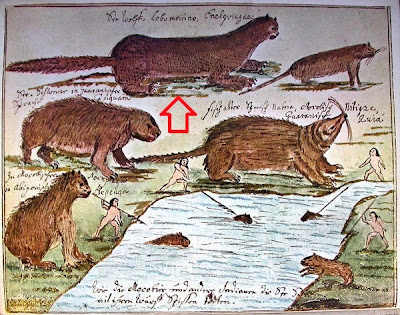Florian Paucke (1719 - 1780) was a Jesuit missionary, born in Bohemia. He spent almost twenty years among the Mocoví natives in the missions of Paraguay between 1749 and 1767, when the Spanish crown siezed the properties of the Jesuit Order and deported its members back to Europe.
Paucke depicted the daily scenes of his mission, the natives and the animals of the surrounding regin in a series of naive watercolors. One of his paintings is reproduced below. It shows a group of natives hunting capivara or carpincho with spears. Around the border of the painting it also shows some aquatic riverine mammals:
During his stay in Southern South America, he encountered different creatures: Carpinchos, jaguars and, as shown in the image above, a very strange seal (red arrow).
Besides painting them, he wrote a book, "From here to there: a stay among the Mocoví Indians (1749-1767)" from which we took the following quote, describing an island on the Paraná River:
"On this tiny island there were many tigers [jaguars] , deer, wild pigs, ostriches [ñandu - Rhea], venison, leopards, [ocelote or Leopardus pardalis mitis] sea wolves and sea pigs (carpinchos) in large quantities....". [1]
He depicted one of the sea wolves, upper central part of the image above. Marked with a red arrow.
The caption above the creature reads: "Sea Wolf, Lobo Marino, enelaviagei ?". In German or English, Spanish and Mocoví ? respectively.
The words Sea and Marino, which is the Spanish word for "belonging to the sea" clearly identify this creature as a sea faring animal. Which is surprising since Paraguay is several hundred kilometers from the sea. The description of a Carpincho as a "Sea Pig" is also surprising since this is definitively a fresh water animal.
Taking a closer look at the "sea wolf", it appears to be very otter-like, with a long slim bushy tail, claws (no webbing between its toes), short ears and short snout. Yet it does not stand up on its legs, it lies on its belly, in a seal-like manner. Quite intriguing indeed!
The Paraná River was home to all the animals that he mentioned in his text, except for the "sea wolves". There were what the Spaniards called Lobitos de río, that is "Tiny River Wolves", which are otters. But he clearly states that they were sea going animals, perhaps implying that they were not otters, but seals.
The larger River wolves were the White-chested Otter (Lutra brasiliensis), the biggest otter in the world, currently found in the Amazon River basin, whose range in the past included the River Plate basin. [3]
But Sea wolf is the Spanish name for a type of seal, not an otter.
Paucke must have surely seen seals and sea wolves when he reached South America, on the islands at the entrance to the River Plate, in an estuarine salt - fresh water area. Even today they can be found on the rocks close to Cabo Polonio, Santa María and Punta del Este, in Uruguay. They may have been more abundant in the 1700s.
But what about the region further upstream, along the Parana and Uruguay Rivers, that flow into the River Plate?
Seals in the River Plate basin
I found a reference that states that phocidae and otariidae (seals) swam upstream along the Parana and Uruguay Rivers [2].
Another reference comes from Spanish naturalist Félix de Azara (1801) who mentions a river over 700 km (435 mi) from the sea, which flows into the Paraná River, as having "sea wolves":
"The Corrientes river is large and bigger than the Guayquiraró: it has sands and breeds many sea wolves, stingrays that sting with cruelty, yacarés [a South American croc] and many other fish." [4]
Sea Wolves are even mentioned in landlocked Salta province, over 1,300 km (800 mi) from Buenos Aires and the sea. Naturalist Holmberg cites Stuar who, in 1878, saw "Sea and river wolves" [5] in Salta. This should not be surprising since the Pilcomayo, Bermejo, Juramento rivers, which flow into the Paraguay and Paraná rivers, reach the Andean foothills in Salta. All of these rivers are part of the River Plate Basin. Seals could, in theory, swim upstream along any of them.
Sources
[1] Florian Paucke. Hacia allá y para acá: (una estada entre los indios Mocobíes, 1749-1767). Vol. 2. pp. 41. Editorial Nuevo Siglo, 2000.
[2] Anales de la Sociedad Científica Argentina, Volumes 127-128. 1939 pp. 295
[3]O. V. Aplin, (1894) Field-Notes on the Mammals of Uruguay. Zoological Society of London
[4] Félix de Azara, (1801). Memorias sobre el estado rural del Rio de la Plata en 1801: Demarcacion ..... Sanchiz, 1847. pp. 34
[5] Claudio Bertonatti, (1994). Los que se van: especies argentinas en peligro.
Editorial Albatros, pp. 244.
Patagonian Monsters - Cryptozoology, Myths & legends in Patagonia Copyright 2009-2014 by Austin Whittall ©

















No comments:
Post a Comment